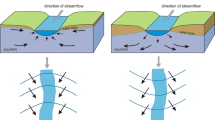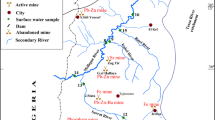Abstract
The migration of nitrates, phosphates and dissolved organic compounds (DOC) in groundwater from fields through meadows to small ponds was analysed. The migration of humic substances, polysugars and polyamides was emphasized. The role of DOC in transporting heavy metals (Cd, Cu, Pb, Zn) was also estimated.
When groundwater from a field was passing under a meadow, a decrease in humic substances and an increase in polyamides and polysugar concentrations were observed. Simultaneously, inorganic forms of heavy metals decreased, while forms bound to DOC increased. Thus, a strip of meadow surrounding an aquatic system, can influence heavy metal migration with groundwater by its impact on DOC.
Moreover, it was found that small mid-field ponds accumulate DOC to a large extent. The concentration of humic substances amounted on average to 34.0 mg l−1 and to 8.2 mg l−1 for polyamides and polysugars, respectively. In such ponds, the concentration of heavy metals, especially Cu and Zn in forms bound to DOC, also increased.
Similar content being viewed by others
References
Antweiler, R. C. & J. I. Drever, 1983. The weathering of late tertiary volcanic ash. Importance or organic solutes. Geochim. Cosmochim. Acta 47: 623–629.
Florence, T. M. & G. E. Batley, 1980. Chemical speciation in waters. CRT Critical Reviews in Analytical Chemistry: 219–296.
Forstner, U. & F. Prosi, 1979. Heavy metal pollution in freshwater ecosystems. In O. Ravera (ed.), Biological aspects of freshwater pollution. Pergamon Press: 129–161.
Hermanowicz, W., W. Dożańska, J. Dojlido & B. Koziorowski, 1976. Fizyczno- chemiczne badanie wody i ścieków, Arkady, Warszawa.
Jackson, T. A., 1975. Humic matter in natural waters and sediments. Soil Sci. 119: 56–64.
Karlik, B. & I. Życzyńska-Baŀoniak, 1985. Soil organic matter leaching from cultivated and uncultivated soils due to liming. INTECOL-Bulletin 12: 103–106.
Lityński, T., H. Jurkowska & E. Gorlach, 1976. Analiza chemiczno-rolnicza PWN, Warszawa
Mantoura, R. F. C. & J. P. Riley, 1975. The analytical concentration of humic substances from natural waters. Analyt. Chim. Acta 76: 97–106.
Martell, A. E., 1971. Principles of complex formation. In S. D. Faust & J. V. Hunter (eds), Organic compounds in aquatic environments. M. Dekker, New York: 239–263.
Ryszkowski, L. & A. Bartoszewicz, 1989. Impact of agricultural landscape structure on cycling of inorganic nutrients. In M. Clarholm & L. Bergstrom (eds), Ecology of arable land. Kluwer Academic Publishers, Dordrecht: 241–245.
Ryszkowski, L., J. Karg, B. Szpakowska & I. Życzyńska-Baŀoniak, 1989. Distribution of phosphorus in meadow and cultivated field ecosystems. In H. Tiessen (ed.), Phosphorus cycles in terrestrial and aquatic ecosystems. 1: Europe, SCOPE and UNEP, Poland: 178–192.
Schitzer, M., 1971. Metal-organic matter interactions in soils and waters. In S. D. Faust & J. V. Hunter (eds), Organic compounds in aquatic environments. M. Dekker, New York: 297–315.
Soil Survey Staff, 1975. Soil Taxonomy: A basic system of soil classification for making and interpreting soil surveys. Agricultural Handbook 436. Washington, D.C.
Steinberg, Ch. & U. Muenster, 1985. Geochemistry and ecological role of humic substances in lakewater. In G. R. Aiken, D. M. McKnight, R. L. Wershaw & P. MacCarthy (eds), Humic substances in soil, sediment and water. John Wiley and Sons, New York: 105–145.
Szpakowska, B., J. Pempkowiak & I. Życzyńska-Baŀoniak, 1986. Comparison of some physicochemical parameters of humic substances isolated from three different aquatic ecosystems. Arch. Hydrobiol. 108: 259–267.
Szpakowska, B. & I. Życzyńska-Baŀoniak, 1989. The effect of environmental pollution on the migration of chemical compounds in water in an agricultural landscape, Ecol. Int. Bull. 17: 41–52.
Thurman, E. M., 1985. Humic substances in groundwater. In G. R. Aiken, D. M. McKnight, R. L. Wershaw & P. MacCarthy (eds), Humic substances in soil, sediment and water. John Wiley and Sons Publ., New York: 87–103.
Życzyńska-Baŀoniak, I., B. Karlik & B. Szpakowska, 1983. The influence of liming on leaching some chemical components from soils (in Polish). Postepy Nauk Roln. 6: 39–45.
Życzyńska-Baŀoniak, I. & B. Szpakowska, 1989. Organic compounds dissolved in water bodies situated in an agricultural landscape and their role for matter migration. Arch. Hydrobiol. Beih. Ergebn. Limnol. 33: 315–322.
Author information
Authors and Affiliations
Rights and permissions
About this article
Cite this article
Życzyńska-Baloniak, I., Szpakowska, B., Ryszkowski, L. et al. Role of meadow strips for migration of dissolved organic compounds and heavy metals with groundwater. Hydrobiologia 251, 249–256 (1993). https://doi.org/10.1007/BF00007184
Issue Date:
DOI: https://doi.org/10.1007/BF00007184




